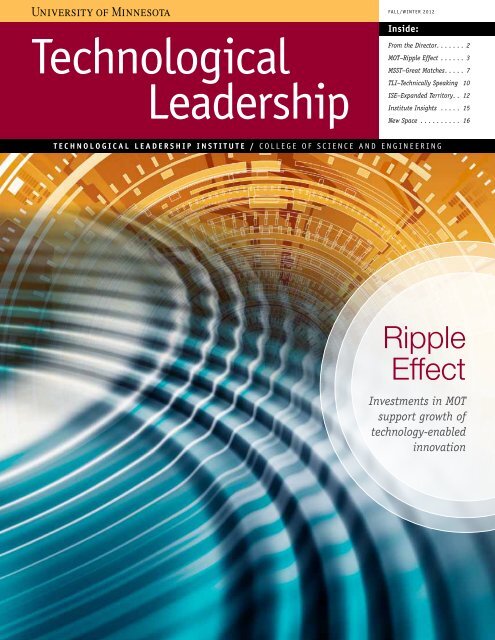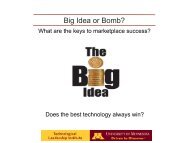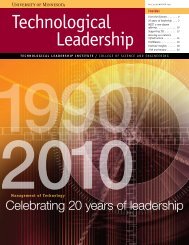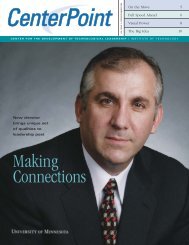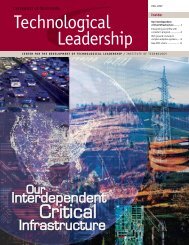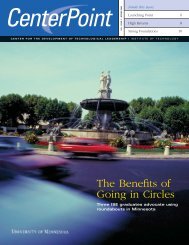Technological Leadership Institute - University of Minnesota
Technological Leadership Institute - University of Minnesota
Technological Leadership Institute - University of Minnesota
- No tags were found...
Create successful ePaper yourself
Turn your PDF publications into a flip-book with our unique Google optimized e-Paper software.
FALL/WINT ER 2012<strong>Technological</strong><strong>Leadership</strong>Inside:From the Director ....... 2MOT–Ripple Effect ...... 3MSST–Great Matches ..... 7TLI–Technically Speaking 10ISE–Expanded Territory .. 12<strong>Institute</strong> Insights ..... 15New Space .......... 16TECHNOLOGICAL L EADERSHIP INST I T U T E / COLLEGE OF SC IENC E AND E NGINEERINGRippleEffectInvestments in MOTsupport growth <strong>of</strong>technology-enabledinnovation
Potential RealizedTLI awards its first MOT scholarships, which recognize thetechnological leadership skills <strong>of</strong> recipients and are inspiringthem to move forward with confidence in their careers.ADAM WICKLUNDFirmware EngineerUponorAdam WicklundRias van Wyk Foresight AwardEver since his father found a description <strong>of</strong>the Master <strong>of</strong> Science in the Management <strong>of</strong>Technology (MOT) program in a course catalog,Adam Wicklund had wanted to attend the program.At the time, he was an undergraduate in electrical and computer I had set my goal to make my way through to the MOT program,” saysWicklund.His determination and talents not only led him to the MOT program,but also earned him significant recognition as the first recipient <strong>of</strong> theRias van Wyk Foresight Award, a merit-based scholarship for highachievingMOT students.JIMMY THIELENSr. Research Engineer3M CorporationAs this article was written, thesecond scholarship awardees werejust being named. Congratulationsto MOT ’13 students Dr. LuisHernandez, recipient <strong>of</strong> the Yechiel(Jack) Shulman <strong>Leadership</strong> Award,and Ms. Kalyani Mallela, recipient <strong>of</strong>the Rias van Wyk Foresight Award.The Rias van Wyk Foresight Award honors a second-year MOTstudent who has demonstrated high potential for excellence ineffectively applying and leveraging technology foresight tools andtechniques. MOT faculty and staff identify students who meet thecriteria, and those students submit an essay on their goals forapplying their knowledge in their careers. Dr. Massoud Amin, director<strong>of</strong> the <strong>Technological</strong> <strong>Leadership</strong> <strong>Institute</strong> (TLI), and Dr. Dennis Polla,Honeywell/W.R. Sweat Chair in Management <strong>of</strong> Technology anddirector <strong>of</strong> graduate studies for the MOT, in consultation with vanWyk, select the recipient.Formerly the Honeywell/W.R. Sweatt Chair in Management <strong>of</strong>Technology, Dr. Rias van Wyk introduced many MOT students to theemerging field <strong>of</strong> technology foresight and forecasting during thistime at the institute. He currently is director <strong>of</strong> Technoscan® Centre<strong>Minnesota</strong>, and serves as president <strong>of</strong> the Management <strong>of</strong> TechnologyAccreditation Board.“It’s truly a great honor,” says Wicklund, who had learned moreabout van Wyk when he researched the program before applying. “Justto be associated with his name, for me, is a tremendous honor.”Receiving the financial support <strong>of</strong> the award is always a plus, butWicklund, who graduated earlier this year, says that the recognition isone <strong>of</strong> the biggest benefits. “It inspires confidence in moving forwardwith my career goals.”Wicklund never forgot his father’s discovery or lost his interest inthe MOT program. After working for several years, he felt it was timeto enhance his skills in managing technology. His MOT experiencehelped Wicklund gain a more strategic perspective, additional businessskills, enhanced s<strong>of</strong>t skills, such as communication and team building,and practical knowledge that he applied on the job.Fall/Winter 2012 5
<strong>of</strong> Portfolio Design Services, Inc., andRosewood Construction Services Corp. pr<strong>of</strong>essor and previous director <strong>of</strong>graduate studies for ISE and AssociatesConsidering the survey findings anddifferent alternatives for the program also<strong>of</strong>fered the opportunity for the facultycommittee to take a close look at thecurrent curriculum with the aim <strong>of</strong> furtherintegrating courses, says Smith.Yes to technologyThe survey showed support for thepossibility <strong>of</strong> a hybrid format, says Long.Almost all ISE students work full time,and greater use <strong>of</strong> technology makes iteasier for students with demanding jobsto maximize their time and efforts.Technology enhances the flexibility andconvenience for students, and levels thegeographic restrictions. “A hybrid programhelps increase the accessibility <strong>of</strong> theprogram,” says Smith, which means thatstudents can participate from around thecountry.One important component <strong>of</strong> hybriddelivery involves synchronous classes,where students come together online atthe same time to interact with otherstudents and their faculty leader. Classesalso may meet periodically for in-personclass sessions. ISE students will continueto enter the program as a cohort, afeature that helps promote networkingand bonding.“As a faculty, we are working to includeas much interaction as we can in theclasses,” says Smith. “We want to ensurethe classroom sessions are very dynamic.”Proposed new nameAs a general theme, survey participantsidentified the importance <strong>of</strong> preparingstudents for leadership responsibilities inmanaging the diverse aspects <strong>of</strong>infrastructure.Although the ISE program incorporatesaspects <strong>of</strong> management, as the facultycommittee considered the transition <strong>of</strong>the curriculum to a hybrid program, theylooked for ways to further strengthenleadership and management components.“The emphasis on leadership aligns wellwith the focus <strong>of</strong> TLI and with many <strong>of</strong>the already existing aspects <strong>of</strong> the ISEprogram,” says Smith. “While it ispredominantly an engineering program asshown in the program map (on page 14),one way to increase its effectiveness is toenhance the management components forstudents.”As a visible reminder <strong>of</strong> the importancethe program places on leadership andmanagement, the committee is proposinga change to the name <strong>of</strong> the program. Ifthe new program is approved by the the current Master <strong>of</strong> Science inInfrastructure Systems Engineering wouldbe known as the Master <strong>of</strong> Science inInfrastructure Systems Management andEngineering. TLI is hoping to launch thenew program in fall 2013.Changing timesDelving into adapting the program toaccommodate greater use <strong>of</strong> technologyallowed the faculty to consider the perspective.With survey results as a guide, facultycommittee members began consideringthe impact on the program’s currentcurriculum. They launched their efforts knowledge needs <strong>of</strong> students and thelearning outcomes that support thoseneeds.“We really started thinking about thevision,” says Smith, “and we focused onoutcomes, asking ourselves the question‘what is it that we want graduates toknow and be able to do.’ ”Answers to those questions are helpingthe program evaluate and leverage itscurrent content and sequencing, saysSmith.Survey participants <strong>of</strong>fered guidance ontopic areas <strong>of</strong> importance to them,including sustainability, advancedmaterials, strategy, and deployment <strong>of</strong>systems, says Long. They also identifiedintegration as a key differentiator <strong>of</strong> theprogram.Through reviewing the currentcurriculum as a whole and comparing itwith key outcomes, faculty membersfound that some areas received moreemphasis than desired while other areascould benefit from more attention.Faculty members agreed that fourknowledge areas surfaced as mostimportant (see related chart on page 14): which includes core competencies, costbenefit assessment, feasibility, science<strong>of</strong> security, design, and emergingtechnology and thought which includes best practices, decisionmaking, leadership, conflictmanagement, planning, and timemanagement written, graphic, and listening,collaboration in different ways, andmarketing and promotion identification <strong>of</strong> critical infrastructures,understanding <strong>of</strong> stakeholders, policydevelopment, current business practices,integrity <strong>of</strong> infrastructure, security andresiliency, and public/private sectorrelationshipsThose areas also help inform thebroader picture, with opportunities forstudents to build their skills while gaininga systems perspective that takes intoaccount program development andmanagement, the business <strong>of</strong> technology,strategic management, innovation,lifecycle management, and riskassessment.Synthesizer remains an important piece <strong>of</strong> thecurriculum. In collaboration with faculty,students select an issue with real-worldapplication to explore. They <strong>of</strong>ten selectprojects that benefit their organizations.Past capstones by alumni involveddevelopment <strong>of</strong> asset managementsystems, new approaches for contracting<strong>of</strong> large-scale public projects, roundaboutsas a traffic control tool, and storm waterimprovements.“Most <strong>of</strong> these capstones are really tiedinto significant changes in the way theorganization works,” says Brad Henry,adjunct faculty member who has taught inthe program since its start. “Students aretaking knowledge and ideas that they arelearning in the program and applyingthem in practical ways.”Fall/Winter 2012 13
Knowledge Areasfor proposed Master <strong>of</strong> Science inInfrastructure Systems Managementand Engineering*45%Engineering, Technology, & ScienceCore competenciesCost benefit assessmentFeasibility: problem identification,formulation and solvingScience <strong>of</strong> securityDesignEmerging technology and thoughtSynthesisCAPSTONEProgram developmentBusiness <strong>of</strong> technologyProject and program managementStrategic managementInnovationLifecycle managementRisk assessmentAPPLICATION AREAS: Transportation Engineering/ Pavement Management: Water Resources /Environmental Engineering; Municipal Engineering;Construction and Maintenance; Geographic InformationSystems: Parks, Recreation and Open Space10%* Subject to approval by the Board <strong>of</strong> Regents <strong>of</strong> the <strong>University</strong> <strong>of</strong> <strong>Minnesota</strong>20%Communications35%Oral, written, graphic, and listeningCollaborating in face-to-face,distributed, and virtual environmentsMarketing and promotingan idea, project, or productManagement <strong>of</strong> Personnel,Projects, and ProgramsBest practicesDecision making<strong>Leadership</strong>Conflict managementPlanningTime management10% GovernanceIdentify critical infrastructuresUnderstanding stakeholdersPolicy developmentCurrent business practicesIntegrity <strong>of</strong> infrastructureSecurity and resiliencyPublic/private sector relationshipsPractical impactCapstone results also can reach thebroader community, multiplying theirimpact. The annual meeting <strong>of</strong> the<strong>Minnesota</strong> Public Works Association,which brings together engineers fromthroughout the state, usually features acapstone presentation by ISE students.This kind <strong>of</strong> practical impact can makea tremendous difference in addressing thecritical infrastructure challenges thatexist in the state and throughout thecountry, says Henry.“We are not spending enough money onthe infrastructure,” says Henry. “With thelack <strong>of</strong> financial investment in theinfrastructure, it becomes even moreimportant than ever to find solutions thatallow us to improve infrastructuremanagement.” The ISE program helpsstudents learn and apply new solutions,he says.Henry, who received his bachelor’sdegree in civil engineering from the well and also has been a leader inapplying new solutions. He spent 31 yearsas a civil engineer for the city <strong>of</strong>Minneapolis, managing and automatingstreet survey and design functions for thepublic works department and coordinatinga citywide geographic information system(GIS). He has been instrumental indeveloping MetroGIS, which makes GISdata and maps available for the entireTwin Cities metro area. He also directeddesign activities for city, county, andstate highway projects and coordinatedGIS functions as a senior transportation “Technology that didn’t exist 20 or 30years ago now <strong>of</strong>fers us new solutions andopportunities,” says Henry, who teachesinfrastructure students about managingcomputer applications and GIS. “We areable to extend the life <strong>of</strong> our existinginfrastructure by making use <strong>of</strong>technology.”Passion and commitmentA group <strong>of</strong> dedicated faculty members,many <strong>of</strong> them adjunct faculty with years<strong>of</strong> experience, remain committed tomaking the program stronger than ever,says Smith.“As faculty, we are really facilitators <strong>of</strong>learning,” he says. “We are always helpingstudents make connections, and we enjoythat role.”Faculty members will continue theirwork throughout 2012 and into 2013.They are using the information aboutoutcomes and the four knowledge areas asthey begin work on redesigning individualcourses. They also will look to incorporatethe technology to the best advantage.“The faculty are passionate about thisprogram,” says Smith. “What’s really greatabout this, it’s something that they thinkis really important to the future <strong>of</strong> thestate and the region and with the hybridprogram to other states.”For updates on the ISE program, visittli.umn.edu/graduate/ise.14 <strong>Technological</strong> <strong>Leadership</strong>
I NST I T U T EInsightsOn the MoveNew positions <strong>of</strong> graduatesManagement <strong>of</strong>Technology1992Barbara Timm-Brock, chiefgrowth <strong>of</strong>ficer, Sylvan Learning,Inc.1999Jon Carlson, TLI AdvisoryBoard member, is CEO <strong>of</strong> BraunIntertec, which was recentlyselected for Minneapolis/St. PaulBusiness Journal’s Fast 50 ListRida Hamza, general managerin Middle East and Africa,HoneywellDennis Taylor, consultingengineer2000Jessie Ni, senior director,Antibody Application and StemCell Departments, R&D SystemsInc.2005Colin Gan, management andtraining consultant, hedge fundmanager, principal, BandungVenturesEduardo Valencia, deputycommissioner, MN.IT Services,State <strong>of</strong> <strong>Minnesota</strong> CTOTim Varecka, manager, hardwareengineering, CardiocomChee Leong Wong, chieftechnology <strong>of</strong>ficer, StrategicMarkets, Thomson Reuters,Beijing2006Melissa Boom Coburn,director <strong>of</strong> Quality and ProgramManagement Office, MTS SystemsDenny Cronin, vice president, Technologies CorporationAerospace Systems2007Edmund Clark, vice president/CIO, <strong>Minnesota</strong> State MankatoKevin Sweeney, senior processdevelopment manager for BostonScientific, Ireland2008Shawn Knowles, director,Technology Scouting, BallCorporation2009Tina Billstrom, principalscientist, MedtronicAndy Harkison, productmanager, Accessories, MTSSystemsErik Peterson, senior manager–Lean Enterprise, EmersonMike Siegler, director <strong>of</strong>engineering, Spectrum DesignSolutionsChris Schmoeckel, vicepresident, Packaged Gas, Chart,Inc.2010Monica Gupta earned theRegulatory Affairs Certified(RAC) CredentialMathew Sandnas, director,Global Engineering–Electronics Systems2013Milena Higgens, director,Litigation KnowledgeManagement, Fish & RichardsonTim Mayville, data storage 2014Brian Dobson was promotedfrom senior component qualityengineer to mechanicalengineering manager at StarkeyHearing TechnologiesSecurity Technologies2011Kyle Martin, securitymonitoring specialist, ING DirectJessica Smithson, technicalanalyst, Integral BusinessSolutions, Inc.Yia Yang, associate scientist, 2012Andrew Albrecht, director,information security, LimitedBrands, parent company <strong>of</strong>Victoria’s Secret, Bath andBody Works, Pink, and LaSenza; he leads security techservices teams, which includeresponsibility for identity andaccess management and securityoperations2013Wells Larsen, security engineer,Target Corp.Infrastructure SystemsEngineering2004Bernard Igbafen Izevbekhai,P.E., Ph.D., research operationsengineer, <strong>Minnesota</strong> Department<strong>of</strong> Transportation, completedhis Ph.D. in civil engineering Pr<strong>of</strong>essors Lev Khazanovich andVaughan Voller served as hisadvisors2006Peter D. Buchen, P.E., assistantstate traffic engineer, Office <strong>of</strong>Traffic, Safety and Technology,<strong>Minnesota</strong> Department <strong>of</strong>Transportation2009Michael Thompson, P.E.,director <strong>of</strong> public works and cityengineer, City <strong>of</strong> Maplewood2012TLI welcomes new accountantAdetayo Dina, seniortransmission engineer, RMT Inc.Ms. Jane Jensen has joined TLI as itsprincipal accountant after serving inaccounting positions at the College<strong>of</strong> Science and Engineering dean’s<strong>of</strong>fice and the College <strong>of</strong> Educationand Human Development’s financialservices <strong>of</strong>fice. She has a broad range <strong>of</strong>interests including sports and the arts,and also has worked in the field <strong>of</strong> industrial security. Sheenjoys any opportunity to travel or garden. She is excited tobe working with the students and staff at TLI.Fall/Winter 2012 15
<strong>Technological</strong> <strong>Leadership</strong> is publishedby the <strong>Technological</strong> <strong>Leadership</strong><strong>Institute</strong> (TLI), College <strong>of</strong> Science andEngineering, <strong>University</strong> <strong>of</strong> <strong>Minnesota</strong>.Direct comments or questions to:Editor, <strong>Technological</strong> <strong>Leadership</strong><strong>Institute</strong>, 290 McNamara AlumniCenter, 200 Oak Street, Minneapolis,MN 55455-2002. 612-624-5747.Fax: 612-624-7510.tli.umn.eduAlternative format available uponrequest.The <strong>Technological</strong> <strong>Leadership</strong> <strong>Institute</strong>was established in 1987 withan endowment from the HoneywellFoundation. The mission <strong>of</strong> TLI is todevelop local and global leaders fortechnology enterprises.The <strong>University</strong> <strong>of</strong> <strong>Minnesota</strong> is an equalopportunity educator and employer.© 2012 Regents <strong>of</strong> <strong>Minnesota</strong>Printed on recycled paper,25% post-consumer fiber.290 McNamara Alumni Center200 Oak StreetMinneapolis, MN 55455-2002Non-Pr<strong>of</strong>it Org.US PostagePAIDTwin Cities, MNPermit No. 90155New Frontiers in SpaceTLI moves its <strong>of</strong>fices and MOT classroomsThis fall, the <strong>Technological</strong> <strong>Leadership</strong><strong>Institute</strong> (TLI) marked a new milestonewhen it comes to space.In September, TLI moved itsadministrative <strong>of</strong>fices and its Master <strong>of</strong>Science in the Management <strong>of</strong> Technology(MOT) program to the heart <strong>of</strong> campus inthe McNamara Alumni Center.“We have faced space challenges withoperating our three master <strong>of</strong> scienceprograms and developing and <strong>of</strong>fering newinitiatives, such as undergraduate coursesand seminars to build leadership skills inundergraduate students,” says Dr. MassoudAmin, TLI director. “We wanted to be surethat our facilities continue to supportgrowth in our programs and outreach tothe technology community.”The new space in McNamara features<strong>of</strong>fices and a high-tech conference roomon the second floor and state-<strong>of</strong>-the-artmeeting rooms for MOT classes on the firstfloor. The current West Bank classroomswill remain home to students in theInfrastructure Systems Engineering andSecurity Technologies programs.TLI welcomes visitorsto its new <strong>of</strong>fices at thefollowing address:McNamara Alumni Center200 Oak Street SESuite 290Minneapolis, MN 55455-2002tli.umn.edu612-624-574716 <strong>Technological</strong> <strong>Leadership</strong> Fall/Winter 2012 16


